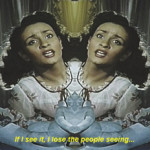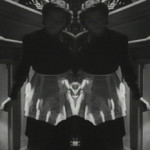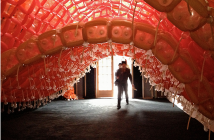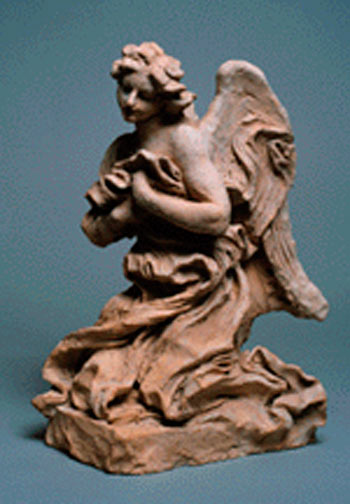On the opening day of Abigail Child’s exhibition of films and prints Mirror World, film theorist Laura Mulvey gave a talk at the Museum of Fine Arts, Boston. A coincidence of scheduling? Of course...but a highly appropriate one. Mulvey’s classic essay “Visual Pleasure and Narrative Cinema” exposes how the Hollywood mainstream (and therefore masculine) “gaze” uses the camera’s frame to objectify and “cut up” female bodies. And Child explores cinematic fragmentation -- especially of women’s bodies -- in ways that would make Mulvey wake up and smell the...carnival.
Yes, it’s a party in Child’s world, and it starts even before you get to the gallery. As you enter the Agassiz House hallway, off of Radcliffe Yard (where Child has been a Bunting Fellow in 2005-06), you can hear overlapping snippets of sound: a waltz; a woman laughing; repeated suspenseful chords; voices in many languages. Step into the Baker Room gallery, and the lights snap on -- Party, Part Two! Three large digital prints are illuminated: each a full-color explosion with shards of images, as if a cockeyed Hall of Mirrors had been erected inside an archive of the twentieth century. A stegosaurus does a face-dive into the streets of Paris; a partitioned box of chocolates (in vertiginous perspective) sets off some nearby bookshelves; a delicately bejeweled hand reaches out, palm up, into a tiny oasis of emptiness. The graininess of many of the image-fragments (which comes from the enlarged dots of half-tone reproductions) suggests that fragmentation already lurks at the root of even the most “representational” images (i.e., those made from the photographic technologies that constitute the roots of film production).
But all of this is just a prologue to the swelling act of the full fiesta. (And to continue the allusion to Macbeth, the “king” that Child is gearing up to “kill” is conventional film narrative: both its form of the beginning-to-end type of storyline and its content, or the subtexts, of ideological presumptions lurking in standard plots.) In the inner chamber of the gallery, Child simultaneously projects three films on different walls, with all their soundtracks running. To the left and right are black-and-white montages of Hollywood’s bygone genres, and ahead (at center stage) is her newest film, a full-color riff on Bollywood. In this room, Child’s fragmentation techniques break into the human realm, and we emerge transformed.
While Mulvey, at the MFA, tried to renew her theories by claiming that today’s film viewer severs narrative sequence by clicking the pause button on a rented DVD (or maybe even -- gasp -- rewind or fast-forward!), Child’s cutting techniques reconfigure sensory/cinematic perception altogether. She often splits the screen down the middle, creating a mirror image: in the exhibition’s title film, Mirror World a woman’s body gets carved into slivers that recombine along the middle seam to create dancing hairy vulvas. Or a typical Bollywood group dance scene takes on an additional visual shimmer. When the screen splits during a subtitled scene inTo and No Fro we are catapulted into a theater of spectacle and sound. Scenes with cameras and other tools of the cinema remind us that Child is constructing our view, but with gleeful humor (the Mirror World film loop “ends” with the main woman character tossing her head back in a long laugh). Child stops short of noise and confusion: a slight back beat (a cymbal; a tabla) steadies first one soundrack, then another; a Strauss waltz builds in intensity and we slip into familiar territory...at least until Child rocks our world once again by turning the footage of the dancers on a slant, or sideways, and even almost (but never predictably) upside-down, before veering off into another quasi-plot. Breathless yet? Hints of narrative are suggested (a glance, a movement, a chord, a subtitle or syllable), intensified (through arrhythmic repetition, intercutting, juxtaposition), and finally thrown overboard (or at least in every conceivable direction). Hindi overlaps with Spanish, English, many styles of music, and sound effects, and the aesthetic of interruption is itself interrupted with steady long shots of landscape and gesture. Child’s writings occasionally appear, like less didactic, more evocative versions of Jenny Holzer’s maxims (“as if to myself”; Every person’s story starts with some other person”; “All humans are unreal”; “Think of me as the self-willed beauty...that is what the world thinks I am”). Child, a self-declared “maximalist,” creates a poetic condensation of contemporary society within the space of one small room.
Upon taking in this array of expressions, we perceive that a set of concerns builds up, with artful indirectness, in all of Child’s films: women’s power; the manipulation of a spectator’s sensibility through the medium of film; large-scale political implications of small moments. These subjects, and the collage technique itself, are not new, but Child’s results are. The Mirror World exhibition can be seen as a millennial updating not only of Mulvey’s theories, but also of an exhibition of paper collages now at the Fogg’s Busch-Reisinger Museum (Tempo, Tempo!: The Bauhaus Photomontages of Marianne Brandt, through May 21). The parallels in subject matter between these two exhibitions are uncanny. Brandt reflects on her position as a woman within male-dominated institutions, considers the scopic pleasures offered by female film stars, and assembles images from many world cultures. But Brandt’s pieces are hardly fiestas. They retain a coolly analytical aesthetic and a precisely calibrated abundance of blank space. Child rejects this approach and revels in experimentalism, intensity, and delight.
After a peek into Abigail Child’s Mirror World the courtyard at Radcliffe has never felt so quiet. Life seems eerily sedate after this carnival ride. But has Child created a “carnival” holiday, which Mikhail Bakhtin famously described as a government-sanctioned period of chaotic excess, whose jubilation provides a necessary release from the seething dreariness of the rest of the year? No. I think Child is saying, more radically, that we have yet to recognize the sensory festival that life already is.
Links:
Abigail Child
Mikhail Bakhtin
Marianne Brandt
Laura Mulvey
"Mirror World" was on view from April 3rd through April 21st in the Baker Room, at Agassiz House, Radcliffe Yard.
All images are courtesy of the artist and Radcliffe Institute for Advanced Study.







